IFM Prototype
This page describes my prototype water rocket with a video camera and wireless transmitter onboard. I bought the camera/transmitter/receiver for less than US$50 from computergeeks.com. Given the low price, this product's performance is astonishing. The camera/transmitter unit weighs only 16 g without batteries. It requires 6.5 to 9.5 volts, and draws 40 to 60 mA current. It transmits its signal at 1.2 GHz with a power of 50 mW. I used seven small rechargeable NiMH button cells with total weight 11 g to power the thing (I bought them in 2002 from allelectronics.com--they are no longer available, but I have seen something similar at goldmine electronics). I power the receiver unit with 8 AA batteries and pipe the audio and video into my camcorder.
As I designed it, the whole video camera and battery assembly is modular, that is, it can be mounted on any rocket. In the pictures below, I have added a more wide-angle lens to the camera than the one that comes with it. The camera/transmitter is on the left. The battery compartment is on the right. In the pictures the compartment has a phono plug attached to the bottom that acts as a power-off switch and battery-charging connection. The camera and battery compartment are mounted on a common boom that is a piece of carbon-fiber shaft used for archery. The antenna is mounted horizontally along the outside of the shaft.
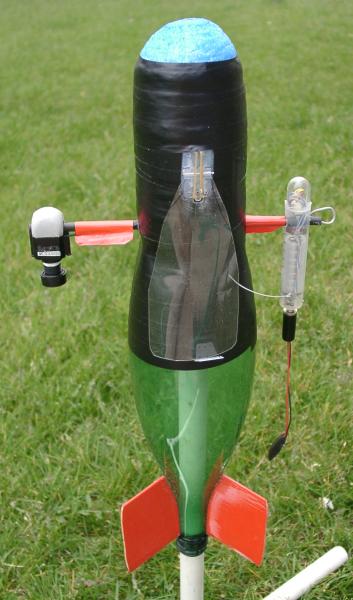
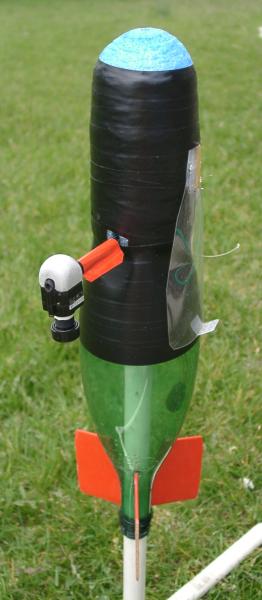
Not shown is a small platform that sits on the top of the bottle and contains a spring-powered mechanism for flipping the camera 180 degrees, so that it points toward the tail during ascent and the nose during descent. The rotation is triggered (hopefully at apogee) by a Johnson air-speed flap. The battery compartment can swivel on the carbon-fiber shaft and so does not rotate with the camera. The remainder of the rocket's nose cone is made of polypropylene foam wrapped in electrical tape. The foam comes from a swimming pool noodle, and is shaped with a Dremel tool and smoothed with heat from a stovetop.
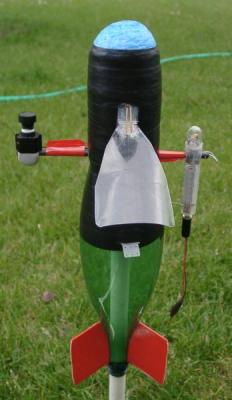
Despite the fact that this rocket has an air-speed flap, it is intended for bounce recovery. I want video from a completely ballistic flight, and in particular while the rocket is speeding toward the earth at its terminal velocity (back-calculated to be 38 m/s or 85 mph). Total mass of the rocket with camera is 120 g.
The pressure vessel is one of the new Perrier 1L soda water bottles made of PET (plastic). The throat section of the bottle is a bit thicker than conventional soda bottles and prevents the unmodified bottle from sliding onto a launch tube (half-inch PVC pipe). I used my Dremel tool to ream out the throat diameter a bit so that a launch tube would fit. I constructed the rocket fins from balsa wood covered in PET film (Ultracote, used by model airplane builders). The fins are attached to the bottle first with CA (super glue) to fix them in the proper position and then with fillets of Goop (a.k.a. Shoe Goo or E6000) to give them a strong flexible hold. During the application and drying of the glues the bottle is pressurized to 4 bar (58 psi) to stretch it tight. Using flight data, I estimate the coefficient of drag for the rocket to be 0.18 based on the area of the widest part of the soda bottle.
Test Flights
I got permission to fly my rocket in Lavell Edwards Stadium at Brigham Young University (Provo, Utah, USA). Since this was the off-season, the field was marked off in a 5-yard grid, which is visible in the videos. The spectators in attendance (the grounds crew on an unofficial lunch break) cheered me on. Estimated apogee height was 80 m for each of the four test flights.
The radio signal was weak, leading to very noisy video recordings. The camera rotation mechanism malfunctioned in two of the four flights (in one it triggered soon after launch; in another it never triggered at all). In addition, the rocket spins as much as 3 to 4 rotations per second which makes you get dizzy watching the video.
Here are two low-quality (due to the poor wireless signal) flight videos encoded in DivX format. Ironically the noise makes the video less compressible and hence increases file sizes.
in-flight movie 1 (1326 KB)
in-flight movie 2 (662)
Here is a picture extracted from movie 1:
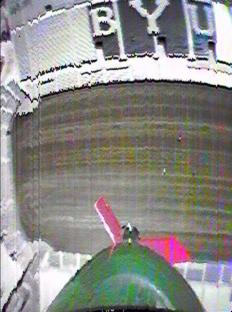
Here are pictures extracted from movie 2 (camera fails to flip at apogee):
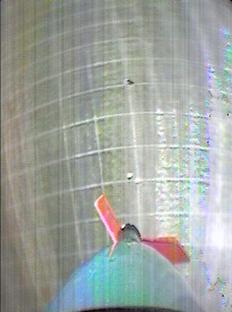
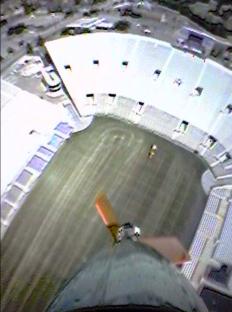
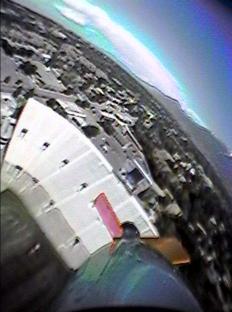
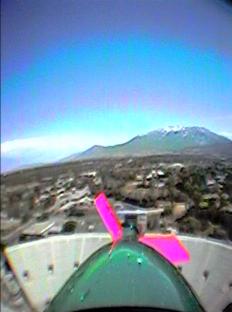
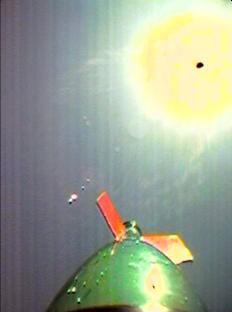
In two of the pictures you can see me standing 15 yards (3 grids) away from the launch spot. The apogee pictures show Mt. Timpanogas (its peak is 2.2 km above the valley floor). The last picture (during rocket descent) replaces the sun with a black dot, a protective feature of the CMOS camera sensor.
Overall I am pleased at how well the rocket survived the brutally strong impacts. I used to think it was hard to build a mechanism than can withstand 250G acceleration during boost. I now realize it is even harder to build one that can withstand around 1000G on crashdown. Incidentally, on impact the spring connection to the batteries got compressed, cutting off power to the camera. Therefore, the movies don't show the fact that the rocket typically bounces about 3 m high, rotates in the air, and comes in for a second nose-first impact.
Plans
- Improve the radio signal strength. Fortunately, my neighbor, a HAM radio operator, has agreed to help me improve the antennae on the transmitter and receiver. Alternatively I may buy higher power transmitters at tinywireless.com.
- Use a cylindrical fin to cut down on spinning.
- Improve the robustness of the mechanism for flipping the camera during flight.
- Make it so the batteries stay connected under high-G accelerations in both directions.
